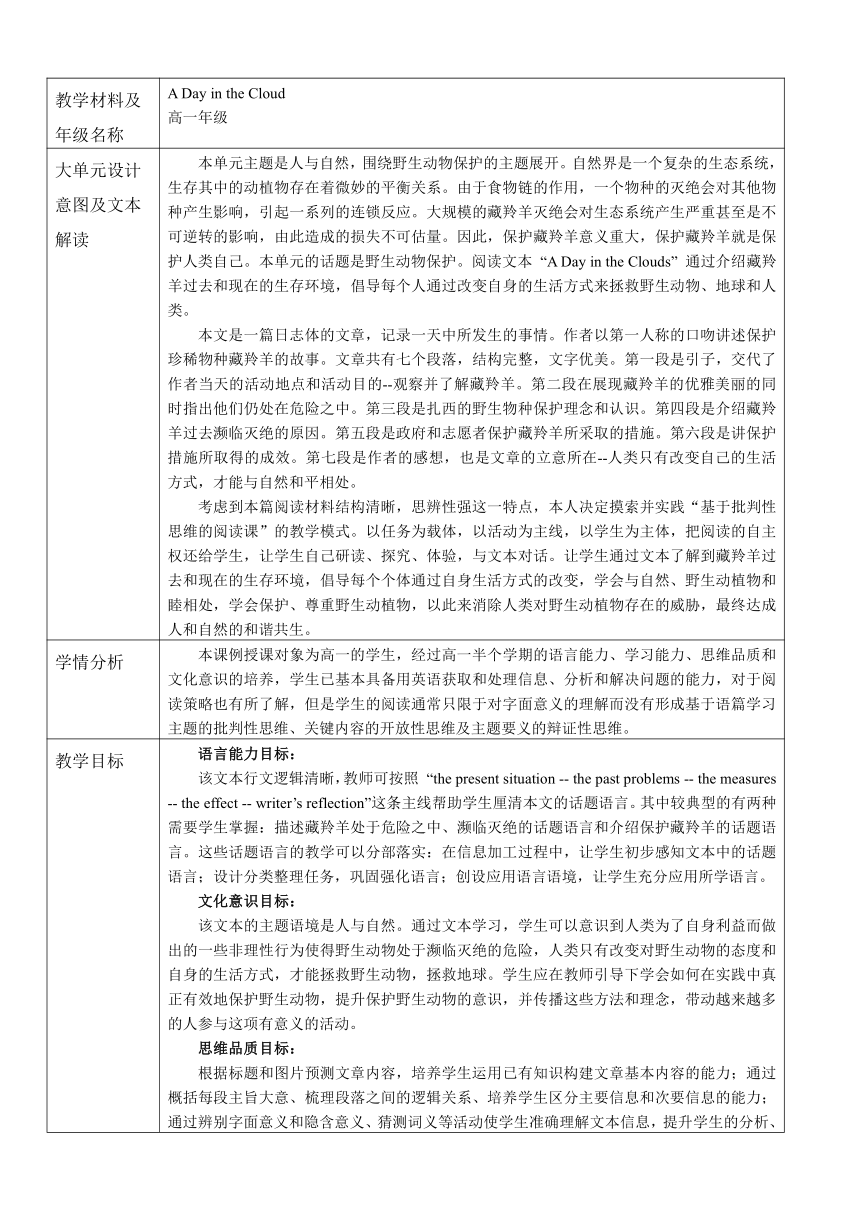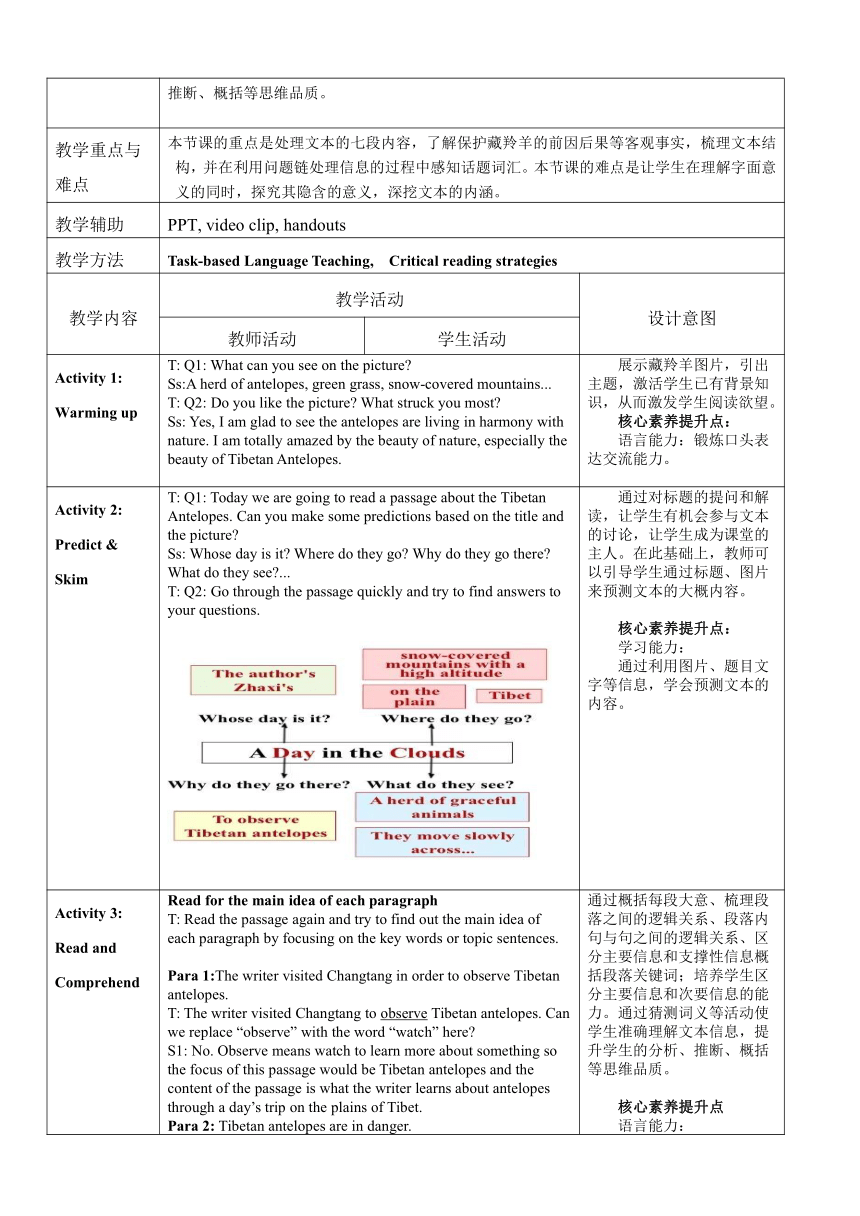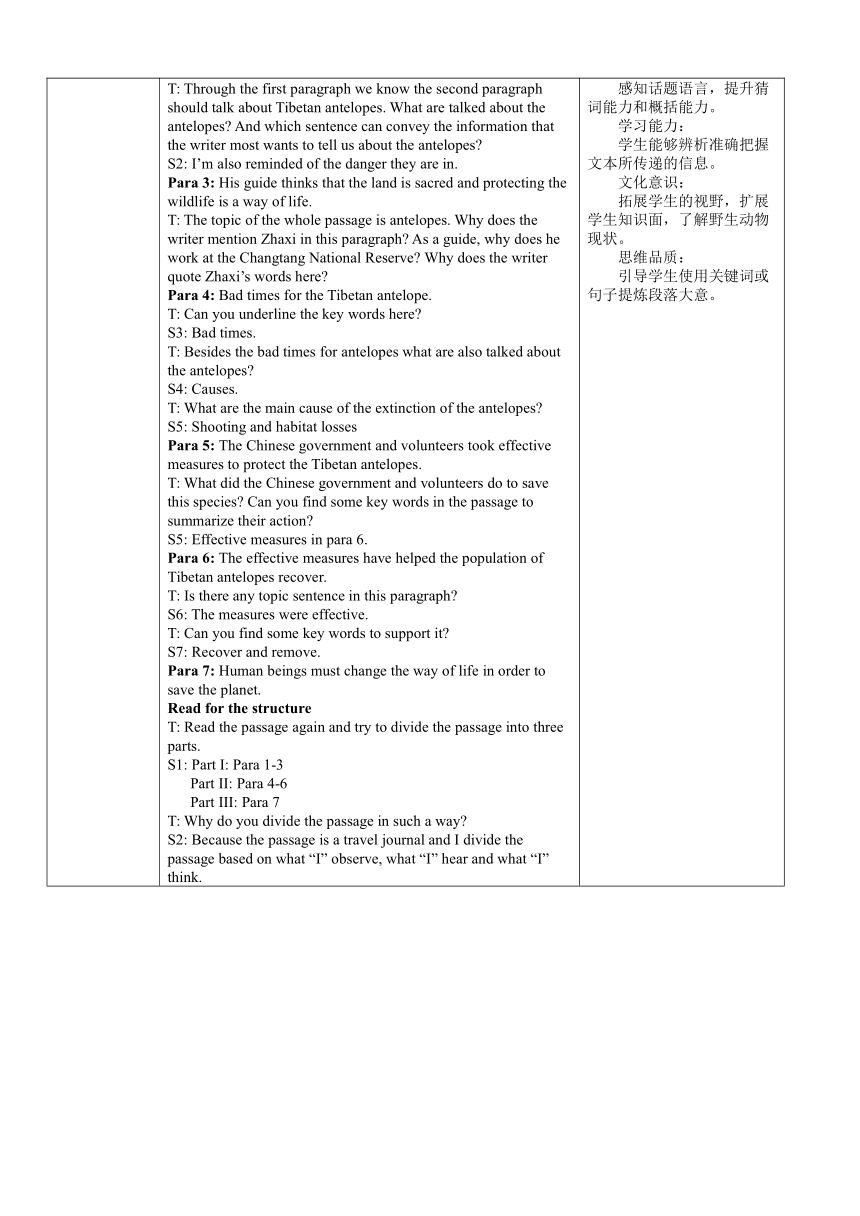人教版(2019) 必修第二册 Unit2 Wildlife protection Reading and Thinking名师教学设计(表格式)
文档属性
| 名称 | 人教版(2019) 必修第二册 Unit2 Wildlife protection Reading and Thinking名师教学设计(表格式) |  | |
| 格式 | docx | ||
| 文件大小 | 159.1KB | ||
| 资源类型 | 教案 | ||
| 版本资源 | 人教版(2019) | ||
| 科目 | 英语 | ||
| 更新时间 | 2023-03-09 19:02:28 | ||
图片预览



文档简介
教学材料及年级名称 A Day in the Cloud 高一年级
大单元设计意图及文本解读 本单元主题是人与自然,围绕野生动物保护的主题展开。自然界是一个复杂的生态系统,生存其中的动植物存在着微妙的平衡关系。由于食物链的作用,一个物种的灭绝会对其他物种产生影响,引起一系列的连锁反应。大规模的藏羚羊灭绝会对生态系统产生严重甚至是不可逆转的影响,由此造成的损失不可估量。因此,保护藏羚羊意义重大,保护藏羚羊就是保护人类自己。本单元的话题是野生动物保护。阅读文本 “A Day in the Clouds” 通过介绍藏羚羊过去和现在的生存环境,倡导每个人通过改变自身的生活方式来拯救野生动物、地球和人类。 本文是一篇日志体的文章,记录一天中所发生的事情。作者以第一人称的口吻讲述保护珍稀物种藏羚羊的故事。文章共有七个段落,结构完整,文字优美。第一段是引子,交代了作者当天的活动地点和活动目的--观察并了解藏羚羊。第二段在展现藏羚羊的优雅美丽的同时指出他们仍处在危险之中。第三段是扎西的野生物种保护理念和认识。第四段是介绍藏羚羊过去濒临灭绝的原因。第五段是政府和志愿者保护藏羚羊所采取的措施。第六段是讲保护措施所取得的成效。第七段是作者的感想,也是文章的立意所在--人类只有改变自己的生活方式,才能与自然和平相处。 考虑到本篇阅读材料结构清晰,思辨性强这一特点,本人决定摸索并实践“基于批判性思维的阅读课”的教学模式。以任务为载体,以活动为主线,以学生为主体,把阅读的自主权还给学生,让学生自己研读、探究、体验,与文本对话。让学生通过文本了解到藏羚羊过去和现在的生存环境,倡导每个个体通过自身生活方式的改变,学会与自然、野生动植物和睦相处,学会保护、尊重野生动植物,以此来消除人类对野生动植物存在的威胁,最终达成人和自然的和谐共生。
学情分析 本课例授课对象为高一的学生,经过高一半个学期的语言能力、学习能力、思维品质和文化意识的培养,学生已基本具备用英语获取和处理信息、分析和解决问题的能力,对于阅读策略也有所了解,但是学生的阅读通常只限于对字面意义的理解而没有形成基于语篇学习主题的批判性思维、关键内容的开放性思维及主题要义的辩证性思维。
教学目标 语言能力目标: 该文本行文逻辑清晰,教师可按照 “the present situation -- the past problems -- the measures -- the effect -- writer’s reflection”这条主线帮助学生厘清本文的话题语言。其中较典型的有两种需要学生掌握:描述藏羚羊处于危险之中、濒临灭绝的话题语言和介绍保护藏羚羊的话题语言。这些话题语言的教学可以分部落实:在信息加工过程中,让学生初步感知文本中的话题语言;设计分类整理任务,巩固强化语言;创设应用语言语境,让学生充分应用所学语言。 文化意识目标: 该文本的主题语境是人与自然。通过文本学习,学生可以意识到人类为了自身利益而做出的一些非理性行为使得野生动物处于濒临灭绝的危险,人类只有改变对野生动物的态度和自身的生活方式,才能拯救野生动物,拯救地球。学生应在教师引导下学会如何在实践中真正有效地保护野生动物,提升保护野生动物的意识,并传播这些方法和理念,带动越来越多的人参与这项有意义的活动。 思维品质目标: 根据标题和图片预测文章内容,培养学生运用已有知识构建文章基本内容的能力;通过概括每段主旨大意、梳理段落之间的逻辑关系、培养学生区分主要信息和次要信息的能力;通过辨别字面意义和隐含意义、猜测词义等活动使学生准确理解文本信息,提升学生的分析、推断、概括等思维品质。
教学重点与难点 本节课的重点是处理文本的七段内容,了解保护藏羚羊的前因后果等客观事实,梳理文本结构,并在利用问题链处理信息的过程中感知话题词汇。本节课的难点是让学生在理解字面意义的同时,探究其隐含的意义,深挖文本的内涵。
教学辅助 PPT, video clip, handouts
教学方法 Task-based Language Teaching, Critical reading strategies
教学内容 教学活动 设计意图
教师活动 学生活动
Activity 1: Warming up T: Q1: What can you see on the picture Ss:A herd of antelopes, green grass, snow-covered mountains... T: Q2: Do you like the picture What struck you most Ss: Yes, I am glad to see the antelopes are living in harmony with nature. I am totally amazed by the beauty of nature, especially the beauty of Tibetan Antelopes. 展示藏羚羊图片,引出主题,激活学生已有背景知识,从而激发学生阅读欲望。 核心素养提升点: 语言能力:锻炼口头表达交流能力。
Activity 2: Predict & Skim T: Q1: Today we are going to read a passage about the Tibetan Antelopes. Can you make some predictions based on the title and the picture Ss: Whose day is it Where do they go Why do they go there What do they see ... T: Q2: Go through the passage quickly and try to find answers to your questions. 通过对标题的提问和解读,让学生有机会参与文本的讨论,让学生成为课堂的主人。在此基础上,教师可以引导学生通过标题、图片来预测文本的大概内容。 核心素养提升点: 学习能力: 通过利用图片、题目文字等信息,学会预测文本的内容。
Activity 3: Read and Comprehend Read for the main idea of each paragraph T: Read the passage again and try to find out the main idea of each paragraph by focusing on the key words or topic sentences. Para 1:The writer visited Changtang in order to observe Tibetan antelopes. T: The writer visited Changtang to observe Tibetan antelopes. Can we replace “observe” with the word “watch” here S1: No. Observe means watch to learn more about something so the focus of this passage would be Tibetan antelopes and the content of the passage is what the writer learns about antelopes through a day’s trip on the plains of Tibet. Para 2: Tibetan antelopes are in danger. T: Through the first paragraph we know the second paragraph should talk about Tibetan antelopes. What are talked about the antelopes And which sentence can convey the information that the writer most wants to tell us about the antelopes S2: I’m also reminded of the danger they are in. Para 3: His guide thinks that the land is sacred and protecting the wildlife is a way of life. T: The topic of the whole passage is antelopes. Why does the writer mention Zhaxi in this paragraph As a guide, why does he work at the Changtang National Reserve Why does the writer quote Zhaxi’s words here Para 4: Bad times for the Tibetan antelope. T: Can you underline the key words here S3: Bad times. T: Besides the bad times for antelopes what are also talked about the antelopes S4: Causes. T: What are the main cause of the extinction of the antelopes S5: Shooting and habitat losses Para 5: The Chinese government and volunteers took effective measures to protect the Tibetan antelopes. T: What did the Chinese government and volunteers do to save this species Can you find some key words in the passage to summarize their action S5: Effective measures in para 6. Para 6: The effective measures have helped the population of Tibetan antelopes recover. T: Is there any topic sentence in this paragraph S6: The measures were effective. T: Can you find some key words to support it S7: Recover and remove. Para 7: Human beings must change the way of life in order to save the planet. Read for the structure T: Read the passage again and try to divide the passage into three parts. S1: Part I: Para 1-3 Part II: Para 4-6 Part III: Para 7 T: Why do you divide the passage in such a way S2: Because the passage is a travel journal and I divide the passage based on what “I” observe, what “I” hear and what “I” think. 通过概括每段大意、梳理段落之间的逻辑关系、段落内句与句之间的逻辑关系、区分主要信息和支撑性信息概括段落关键词;培养学生区分主要信息和次要信息的能力。通过猜测词义等活动使学生准确理解文本信息,提升学生的分析、推断、概括等思维品质。 核心素养提升点 语言能力: 感知话题语言,提升猜词能力和概括能力。 学习能力: 学生能够辨析准确把握文本所传递的信息。 文化意识: 拓展学生的视野,扩展学生知识面,了解野生动物现状。 思维品质: 引导学生使用关键词或句子提炼段落大意。
Activity 4: Read and Comprehend T: Read each part in detail and I will ask you more questions. What “I” observe: T: Where does the antelope live S1: They live on the plains of Tibet, Xinjiang. T: What is the place where they live like Is it suitable for them to live in S2: They live in a place where the air is thin (It is at high altitude and not suitable for humans to live in.) and snow-covered mountains disappear into clouds that seem almost close enough to touch (It must be very cold there and few people live there). T: What kind of life do the antelopes live S3: They must live a peaceful life. T: Do they really live a peaceful life as it appears How do you understand this sentence: I am also reminded of the danger they are in. (Tip for reading: When the meaning is implied in the text but not directly stated, we must learn to infer.) What “I” hear: T: Fill in the blanks and try to get basic information about the antelope. The Basic InformationThe problemare in dangerCausesIllegal shooting and habitat losses contribute to the problem.EffortsThe volunteers and the government are working together to improve the situation.
What “I” hear: The volunters’ efforts: T: What does Zhaxi do S4: Zhaxi works at the Changtang National Nature Reserve which is a shelter for the animals and plants of northwestern Tibet. T: What is Zhaxi’s attitude towards protecting wildlife S5: Zhaxi thinks that the land is sacred and protecting the wildlife is a way of life. T: What does the word “sacred” mean S6: ... T: “Sacred” is connected with God or a god and considered to be holy. From this word, we can know that he holds a respectful attitude towards nature. T: How do you understand this sentence -- We are not trying to save the animal. Actually, we’re trying to save ourselves. S7: No protection, no antelopes, no humans. What “I” hear: The Government’s efforts T: What happened to the Tibetan antelope in the 1980s and 1990s S8: The population dropped by more than 50 percent. T: Did the government take any measures and what was the result S9: The antelope population has recovered and in June 2015, the Tibetan antelope was removed from the endangered species list. T: Why does the government stop the protection programmes S10: Because threats still exist. T: Then how can we solve this problem and what is the writer’s opinion Please read the last paragraph. What “I” think: Our efforts T: After a day’s observation, what does the author think about the future S8: To save our planet, we must change our way of life. T: Why does the writer uses so many “we”s in the passage What does it refer to and imply S9: All human beings need to make changes. T: What is the writer’s purpose of writing this passage S10: To call on all the people to take action. 该教学活动以语篇为载体,通过重现语篇中的信息,给出字面意义和隐含意义的基本定义,并通过一个个问题,夯实对语篇文字的字面意义和隐含意义的正确理解。依托关键问题导引的信息层次化解读文本。 核心素养提升点: 提升学生推理判断的能力并培养学生思维的层次性。 树立学生的主人翁意识,坚持推动构建人类命运共同体。
Activity 5: Discuss T: Do you agree that we must change our way of life to save our planet Why and how What is our bad way of life Why is it harmful How to change
Words and expressions for reference: In my opinion, we should / shouldn’t ... The reasons are as follows: .... To save our planet, we should .... Example given by the teacher: What is our bad way of lifeWhy is it harmful How to changeWearing Shahtoosh has become a fashion among the rich. The birth of one Shahtoosh means the death of 4 antelopes. appeal for awareness take forceful measures get / receive severe punishment
Students come up with different ways of life which are harmful. 通过图片展示,输入“沙图什披肩”的背景知识,引起学生对藏羚羊的担忧和关怀之情,进而引导学生探究“人类不健康的生活方式与藏羚羊生存危机之间的关系及解决办法”。 在“人与自然”这一主题语境下,调动学生已有的基于该主题的经验,建构和完善新的知识结构,深化对该主题的理解和认识。同时通过表格,强化基于主题整理词块的意识。在相关话题的表达过程中,提高词汇使用的准确性和丰富性。 核心素养提升点: 树立对野生动物进行保护并在日常生活中践行的意识。
Activity 6: Conclusion T: Let’s summarize what we have learnt based on the following questions. Why do we need to protect the antelopes What caused the disappearance of the antelopes How can we save the antelope What is the results of our present efforts Is there anything more we can do save the animal 依托主题思维导图的语篇结构化解读来培养学生的思维可视性。
家庭作业: Suppose you are the writer and you have returned from the journey. Your headmaster asked you to deliver a speech about the Tibetan antelopes. It may include the following parts: The antelopes’ life in the past (problems and causes) Their present situation (improvements and reasons) What we should do to protect the antelopes (reasons and measures) Dear students, I have just returned from the plain. I was really struck by the graceful antelopes and snow-covered mountains there. But if you go there during 1980s and 1990s, things could turn out quite different. At that time, ... Fortunately, ... Only when we change our way of life, can we live .... 帮助学生梳理、整合写作所需的词块。通过搭建支架,帮助学生巩固所学内容,整合运用语言进行书面表达,完成主体内容、语言知识和文化意识的迁移应用。 核心素养提升点: 发展总体运用语言的能力
板书设计: The Tibetan Antelopes What “I” observe What “I” hear A travel journal What “I” think
教学反思: 本课时首先通过图片引出文本话题,然后引导学生根据标题对文本内容进行预测,然后进行整体阅读,最后转到各个段落的理解,几部分的输出效果都不错。实施的每个环节也较为顺畅,每一个活动的小目标也基本达成。例如,在预测环节,学生自主参与问题的设计并点名让同学回答的方式很好地激发了学生的学习兴趣,他们提出的问题与文本的内容相关度很高。 在分块处理信息的环节,问题链的设置能够很好地帮助学生梳理出文本主线,更有利于学生思考深层的内在信息及各部分内容之间的逻辑关系。而且在问与答环节,将语言学习和文本内容教学恰当结合,有利于学生理解和记忆词汇。 本节课的亮点主要有以下两个方面:一、课堂开放空间扩大,突出了学生在学习过程中的主体性和自主性。学生有了自主解读文本、自主探究的机会。同时学习文章严密的信息安排技巧;通过辨别字面意义和隐含意义、猜测词义等活动使学生准确理解文本信息,提升学生的分析、推断、概括等思维品质,从而使思维品质的提升得到了有效的落实。二、注重拓展语篇内容,联系实际迁移应用,从而塑造文化品格。本课堂适时补充了相关拓展内容,比如:啥图什披肩等。拓展内容直观,学生倍感震惊,激发了学生保护藏羚羊的强烈愿望。 反思本堂课的不足之处:从语料的真实性来看,有的话题没有充分考虑学生的学习需求,例如Changtang National Nature Reserve 的话题与学生认知体验脱节,导致无话可说,不利于学生语用能力的培养,应在单元大主题内通过情境连贯性加以改进,设计更多的藏区生活和环境的小场景将学习者引入连贯立体的主题语境脉络,培养学生的英语思维和综合语用能力。
大单元设计意图及文本解读 本单元主题是人与自然,围绕野生动物保护的主题展开。自然界是一个复杂的生态系统,生存其中的动植物存在着微妙的平衡关系。由于食物链的作用,一个物种的灭绝会对其他物种产生影响,引起一系列的连锁反应。大规模的藏羚羊灭绝会对生态系统产生严重甚至是不可逆转的影响,由此造成的损失不可估量。因此,保护藏羚羊意义重大,保护藏羚羊就是保护人类自己。本单元的话题是野生动物保护。阅读文本 “A Day in the Clouds” 通过介绍藏羚羊过去和现在的生存环境,倡导每个人通过改变自身的生活方式来拯救野生动物、地球和人类。 本文是一篇日志体的文章,记录一天中所发生的事情。作者以第一人称的口吻讲述保护珍稀物种藏羚羊的故事。文章共有七个段落,结构完整,文字优美。第一段是引子,交代了作者当天的活动地点和活动目的--观察并了解藏羚羊。第二段在展现藏羚羊的优雅美丽的同时指出他们仍处在危险之中。第三段是扎西的野生物种保护理念和认识。第四段是介绍藏羚羊过去濒临灭绝的原因。第五段是政府和志愿者保护藏羚羊所采取的措施。第六段是讲保护措施所取得的成效。第七段是作者的感想,也是文章的立意所在--人类只有改变自己的生活方式,才能与自然和平相处。 考虑到本篇阅读材料结构清晰,思辨性强这一特点,本人决定摸索并实践“基于批判性思维的阅读课”的教学模式。以任务为载体,以活动为主线,以学生为主体,把阅读的自主权还给学生,让学生自己研读、探究、体验,与文本对话。让学生通过文本了解到藏羚羊过去和现在的生存环境,倡导每个个体通过自身生活方式的改变,学会与自然、野生动植物和睦相处,学会保护、尊重野生动植物,以此来消除人类对野生动植物存在的威胁,最终达成人和自然的和谐共生。
学情分析 本课例授课对象为高一的学生,经过高一半个学期的语言能力、学习能力、思维品质和文化意识的培养,学生已基本具备用英语获取和处理信息、分析和解决问题的能力,对于阅读策略也有所了解,但是学生的阅读通常只限于对字面意义的理解而没有形成基于语篇学习主题的批判性思维、关键内容的开放性思维及主题要义的辩证性思维。
教学目标 语言能力目标: 该文本行文逻辑清晰,教师可按照 “the present situation -- the past problems -- the measures -- the effect -- writer’s reflection”这条主线帮助学生厘清本文的话题语言。其中较典型的有两种需要学生掌握:描述藏羚羊处于危险之中、濒临灭绝的话题语言和介绍保护藏羚羊的话题语言。这些话题语言的教学可以分部落实:在信息加工过程中,让学生初步感知文本中的话题语言;设计分类整理任务,巩固强化语言;创设应用语言语境,让学生充分应用所学语言。 文化意识目标: 该文本的主题语境是人与自然。通过文本学习,学生可以意识到人类为了自身利益而做出的一些非理性行为使得野生动物处于濒临灭绝的危险,人类只有改变对野生动物的态度和自身的生活方式,才能拯救野生动物,拯救地球。学生应在教师引导下学会如何在实践中真正有效地保护野生动物,提升保护野生动物的意识,并传播这些方法和理念,带动越来越多的人参与这项有意义的活动。 思维品质目标: 根据标题和图片预测文章内容,培养学生运用已有知识构建文章基本内容的能力;通过概括每段主旨大意、梳理段落之间的逻辑关系、培养学生区分主要信息和次要信息的能力;通过辨别字面意义和隐含意义、猜测词义等活动使学生准确理解文本信息,提升学生的分析、推断、概括等思维品质。
教学重点与难点 本节课的重点是处理文本的七段内容,了解保护藏羚羊的前因后果等客观事实,梳理文本结构,并在利用问题链处理信息的过程中感知话题词汇。本节课的难点是让学生在理解字面意义的同时,探究其隐含的意义,深挖文本的内涵。
教学辅助 PPT, video clip, handouts
教学方法 Task-based Language Teaching, Critical reading strategies
教学内容 教学活动 设计意图
教师活动 学生活动
Activity 1: Warming up T: Q1: What can you see on the picture Ss:A herd of antelopes, green grass, snow-covered mountains... T: Q2: Do you like the picture What struck you most Ss: Yes, I am glad to see the antelopes are living in harmony with nature. I am totally amazed by the beauty of nature, especially the beauty of Tibetan Antelopes. 展示藏羚羊图片,引出主题,激活学生已有背景知识,从而激发学生阅读欲望。 核心素养提升点: 语言能力:锻炼口头表达交流能力。
Activity 2: Predict & Skim T: Q1: Today we are going to read a passage about the Tibetan Antelopes. Can you make some predictions based on the title and the picture Ss: Whose day is it Where do they go Why do they go there What do they see ... T: Q2: Go through the passage quickly and try to find answers to your questions. 通过对标题的提问和解读,让学生有机会参与文本的讨论,让学生成为课堂的主人。在此基础上,教师可以引导学生通过标题、图片来预测文本的大概内容。 核心素养提升点: 学习能力: 通过利用图片、题目文字等信息,学会预测文本的内容。
Activity 3: Read and Comprehend Read for the main idea of each paragraph T: Read the passage again and try to find out the main idea of each paragraph by focusing on the key words or topic sentences. Para 1:The writer visited Changtang in order to observe Tibetan antelopes. T: The writer visited Changtang to observe Tibetan antelopes. Can we replace “observe” with the word “watch” here S1: No. Observe means watch to learn more about something so the focus of this passage would be Tibetan antelopes and the content of the passage is what the writer learns about antelopes through a day’s trip on the plains of Tibet. Para 2: Tibetan antelopes are in danger. T: Through the first paragraph we know the second paragraph should talk about Tibetan antelopes. What are talked about the antelopes And which sentence can convey the information that the writer most wants to tell us about the antelopes S2: I’m also reminded of the danger they are in. Para 3: His guide thinks that the land is sacred and protecting the wildlife is a way of life. T: The topic of the whole passage is antelopes. Why does the writer mention Zhaxi in this paragraph As a guide, why does he work at the Changtang National Reserve Why does the writer quote Zhaxi’s words here Para 4: Bad times for the Tibetan antelope. T: Can you underline the key words here S3: Bad times. T: Besides the bad times for antelopes what are also talked about the antelopes S4: Causes. T: What are the main cause of the extinction of the antelopes S5: Shooting and habitat losses Para 5: The Chinese government and volunteers took effective measures to protect the Tibetan antelopes. T: What did the Chinese government and volunteers do to save this species Can you find some key words in the passage to summarize their action S5: Effective measures in para 6. Para 6: The effective measures have helped the population of Tibetan antelopes recover. T: Is there any topic sentence in this paragraph S6: The measures were effective. T: Can you find some key words to support it S7: Recover and remove. Para 7: Human beings must change the way of life in order to save the planet. Read for the structure T: Read the passage again and try to divide the passage into three parts. S1: Part I: Para 1-3 Part II: Para 4-6 Part III: Para 7 T: Why do you divide the passage in such a way S2: Because the passage is a travel journal and I divide the passage based on what “I” observe, what “I” hear and what “I” think. 通过概括每段大意、梳理段落之间的逻辑关系、段落内句与句之间的逻辑关系、区分主要信息和支撑性信息概括段落关键词;培养学生区分主要信息和次要信息的能力。通过猜测词义等活动使学生准确理解文本信息,提升学生的分析、推断、概括等思维品质。 核心素养提升点 语言能力: 感知话题语言,提升猜词能力和概括能力。 学习能力: 学生能够辨析准确把握文本所传递的信息。 文化意识: 拓展学生的视野,扩展学生知识面,了解野生动物现状。 思维品质: 引导学生使用关键词或句子提炼段落大意。
Activity 4: Read and Comprehend T: Read each part in detail and I will ask you more questions. What “I” observe: T: Where does the antelope live S1: They live on the plains of Tibet, Xinjiang. T: What is the place where they live like Is it suitable for them to live in S2: They live in a place where the air is thin (It is at high altitude and not suitable for humans to live in.) and snow-covered mountains disappear into clouds that seem almost close enough to touch (It must be very cold there and few people live there). T: What kind of life do the antelopes live S3: They must live a peaceful life. T: Do they really live a peaceful life as it appears How do you understand this sentence: I am also reminded of the danger they are in. (Tip for reading: When the meaning is implied in the text but not directly stated, we must learn to infer.) What “I” hear: T: Fill in the blanks and try to get basic information about the antelope. The Basic InformationThe problemare in dangerCausesIllegal shooting and habitat losses contribute to the problem.EffortsThe volunteers and the government are working together to improve the situation.
What “I” hear: The volunters’ efforts: T: What does Zhaxi do S4: Zhaxi works at the Changtang National Nature Reserve which is a shelter for the animals and plants of northwestern Tibet. T: What is Zhaxi’s attitude towards protecting wildlife S5: Zhaxi thinks that the land is sacred and protecting the wildlife is a way of life. T: What does the word “sacred” mean S6: ... T: “Sacred” is connected with God or a god and considered to be holy. From this word, we can know that he holds a respectful attitude towards nature. T: How do you understand this sentence -- We are not trying to save the animal. Actually, we’re trying to save ourselves. S7: No protection, no antelopes, no humans. What “I” hear: The Government’s efforts T: What happened to the Tibetan antelope in the 1980s and 1990s S8: The population dropped by more than 50 percent. T: Did the government take any measures and what was the result S9: The antelope population has recovered and in June 2015, the Tibetan antelope was removed from the endangered species list. T: Why does the government stop the protection programmes S10: Because threats still exist. T: Then how can we solve this problem and what is the writer’s opinion Please read the last paragraph. What “I” think: Our efforts T: After a day’s observation, what does the author think about the future S8: To save our planet, we must change our way of life. T: Why does the writer uses so many “we”s in the passage What does it refer to and imply S9: All human beings need to make changes. T: What is the writer’s purpose of writing this passage S10: To call on all the people to take action. 该教学活动以语篇为载体,通过重现语篇中的信息,给出字面意义和隐含意义的基本定义,并通过一个个问题,夯实对语篇文字的字面意义和隐含意义的正确理解。依托关键问题导引的信息层次化解读文本。 核心素养提升点: 提升学生推理判断的能力并培养学生思维的层次性。 树立学生的主人翁意识,坚持推动构建人类命运共同体。
Activity 5: Discuss T: Do you agree that we must change our way of life to save our planet Why and how What is our bad way of life Why is it harmful How to change
Words and expressions for reference: In my opinion, we should / shouldn’t ... The reasons are as follows: .... To save our planet, we should .... Example given by the teacher: What is our bad way of lifeWhy is it harmful How to changeWearing Shahtoosh has become a fashion among the rich. The birth of one Shahtoosh means the death of 4 antelopes. appeal for awareness take forceful measures get / receive severe punishment
Students come up with different ways of life which are harmful. 通过图片展示,输入“沙图什披肩”的背景知识,引起学生对藏羚羊的担忧和关怀之情,进而引导学生探究“人类不健康的生活方式与藏羚羊生存危机之间的关系及解决办法”。 在“人与自然”这一主题语境下,调动学生已有的基于该主题的经验,建构和完善新的知识结构,深化对该主题的理解和认识。同时通过表格,强化基于主题整理词块的意识。在相关话题的表达过程中,提高词汇使用的准确性和丰富性。 核心素养提升点: 树立对野生动物进行保护并在日常生活中践行的意识。
Activity 6: Conclusion T: Let’s summarize what we have learnt based on the following questions. Why do we need to protect the antelopes What caused the disappearance of the antelopes How can we save the antelope What is the results of our present efforts Is there anything more we can do save the animal 依托主题思维导图的语篇结构化解读来培养学生的思维可视性。
家庭作业: Suppose you are the writer and you have returned from the journey. Your headmaster asked you to deliver a speech about the Tibetan antelopes. It may include the following parts: The antelopes’ life in the past (problems and causes) Their present situation (improvements and reasons) What we should do to protect the antelopes (reasons and measures) Dear students, I have just returned from the plain. I was really struck by the graceful antelopes and snow-covered mountains there. But if you go there during 1980s and 1990s, things could turn out quite different. At that time, ... Fortunately, ... Only when we change our way of life, can we live .... 帮助学生梳理、整合写作所需的词块。通过搭建支架,帮助学生巩固所学内容,整合运用语言进行书面表达,完成主体内容、语言知识和文化意识的迁移应用。 核心素养提升点: 发展总体运用语言的能力
板书设计: The Tibetan Antelopes What “I” observe What “I” hear A travel journal What “I” think
教学反思: 本课时首先通过图片引出文本话题,然后引导学生根据标题对文本内容进行预测,然后进行整体阅读,最后转到各个段落的理解,几部分的输出效果都不错。实施的每个环节也较为顺畅,每一个活动的小目标也基本达成。例如,在预测环节,学生自主参与问题的设计并点名让同学回答的方式很好地激发了学生的学习兴趣,他们提出的问题与文本的内容相关度很高。 在分块处理信息的环节,问题链的设置能够很好地帮助学生梳理出文本主线,更有利于学生思考深层的内在信息及各部分内容之间的逻辑关系。而且在问与答环节,将语言学习和文本内容教学恰当结合,有利于学生理解和记忆词汇。 本节课的亮点主要有以下两个方面:一、课堂开放空间扩大,突出了学生在学习过程中的主体性和自主性。学生有了自主解读文本、自主探究的机会。同时学习文章严密的信息安排技巧;通过辨别字面意义和隐含意义、猜测词义等活动使学生准确理解文本信息,提升学生的分析、推断、概括等思维品质,从而使思维品质的提升得到了有效的落实。二、注重拓展语篇内容,联系实际迁移应用,从而塑造文化品格。本课堂适时补充了相关拓展内容,比如:啥图什披肩等。拓展内容直观,学生倍感震惊,激发了学生保护藏羚羊的强烈愿望。 反思本堂课的不足之处:从语料的真实性来看,有的话题没有充分考虑学生的学习需求,例如Changtang National Nature Reserve 的话题与学生认知体验脱节,导致无话可说,不利于学生语用能力的培养,应在单元大主题内通过情境连贯性加以改进,设计更多的藏区生活和环境的小场景将学习者引入连贯立体的主题语境脉络,培养学生的英语思维和综合语用能力。
